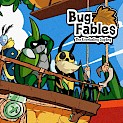Review: Bug Fables: The Everlasting Sapling

Posted 02 Jul 2020 at 13:54 by Sam C Gittins
Sometimes it is not difficult to see where a game gets its inspiration from. In the case of Bug Fables, it is quite obvious that Nintendo’s Paper Mario series served as a model. But there is a big difference between being inspired by, or copying, a game. Bug Fables may have borrowed the graphical style and a number of gameplay elements from the paper plumber. But the setting, story, and cast of unique and memorable characters give this game more than enough right to exist. While the source material inspiration for Bug Fables is clear, you can't help but marvel at just how well put together this unique title is.
This introduction may sound like a conclusion, and you may already feel that we are talking about at least a decent game here. But it is more meant to tackle the elephant in the room, and make clear that we are definitely not dealing with a Paper Mario clone here. So yes, in this review we will highlight some of the similarities, but we also want to show where this game shines and how much of a unique experience it is.
Let’s start with the theme of this game. You probably already figured out by the title of this game that bugs play a big role. In fact, the whole game takes place in Bugaria, where ants, wasps, bees, and more crawly critters roam. If this bugs you then be warned because you will be embarking on a 25-or-so hour quest with them. Luckily, these are not the typical nasty ones that you encounter in the park or your backyard, but instead we are looking at cute, brave, and funny creatures leading their own life.
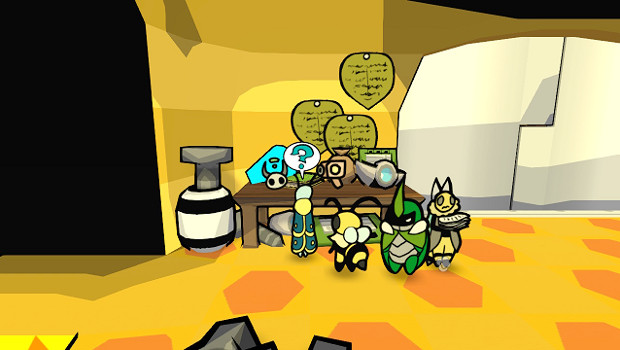 That surely can't be? Hollow Knight... is that you?
That surely can't be? Hollow Knight... is that you?
In this world of Bugaria you start off as Kabbu, a beetle looking to be an explorer. Explorers in Bugaria help people with quests and are mostly regarded as the cool ones, although you require a party and a permit to become one. So rather quickly, Kabbu enlists Vi the bee and Leif the moth, and your real adventure begins.
You accept a quest from none other than the queen of the ant kingdom, Elizanth II. She is searching for the mythical Everlasting Sapling, a plant that can bestow eternal life. But in order to be able to find it you need to find a number of artefacts that can help you. This means traversing all of Bugaria, which is not an easy task, due to all of the politics between the different kingdoms and all the enemies and hazards you will encounter.
Being explorers Kabbu, Vi, and Leif know how to pack a punch, and that’s a good thing since battles are frequent in this game. Every battle starts by an encounter on the overworld, so if you don’t feel like battling you can always bypass your foes.
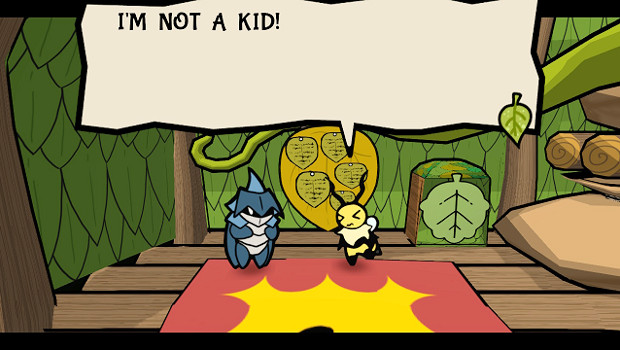 It's never a good idea to call Vi the Bee a kid, she'll get into a flap.
It's never a good idea to call Vi the Bee a kid, she'll get into a flap.
Your party always starts in a triangular setup, with one character in the front and two in the back. The one up front is the one most likely to take the hits, but luckily you can rotate your triangle as well. Battles are turn-based, but with a twist. Each character has a standard attack which requires a certain input based on timing. Vi, for example, throws a boomerang, but in order to do most damage you need to push the attack button again when you reach the green part of a slider.
Next to these basic attacks, you can also use items or do a special attack. This costs TP (Team Power), but they are more powerful attacks and have different perks, like being able to attack multiple enemies or cause a side effect like freezing. These special attacks also often require a specific timing or button input, so even though fighting is turn-based, you still need to be sharp. Even enemy attacks can be countered with a well-timed button input. Combat is fast, fluid, and has a very satisfying loop when grinding for experience, which makes for a very enjoyable time indeed.
When the battle is over, you gain experience, and after 100 or so experience points you level up. At every level up, you can choose what perk you want to increase: Health, for some longer durability in battles; Team Power, so you can perform more special moves; or Medal, which lets you equip more medals.
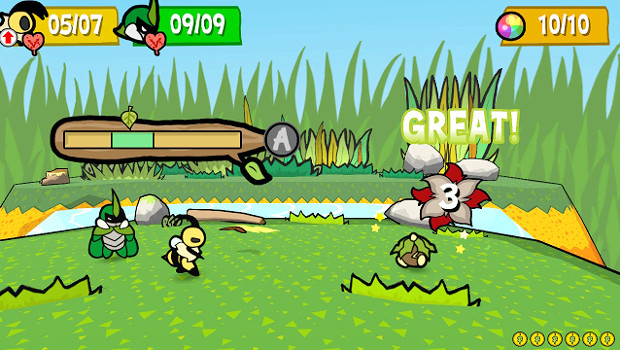 Vi is deadly in combat with her long-range Beemerang.
Vi is deadly in combat with her long-range Beemerang.
Medals are the key to personalize your team. You can collect them from shops, find them in dungeons, or earn them by finishing side quests. There are medals that give you more HP, more TP, resistance to stat changes (such as sleep and poison), medals that make you hit harder, the list goes on.
There is also an incentive for ramping up the difficulty, as very early on you will receive a medal which, when equipped, makes the enemies hit you for a higher amount of damage, but also ups the amount of experience. While it's probably not worth the short-term gain for most of the game, it's certainly worth using when it comes to each boss battle, as defeating the bosses with this badge equipped will grant you rewards from an NPC which is very much worth your time. Because this is a medal which you can toggle on and off at almost any time, it's a good way to find your ideal difficulty, if you're finding the battles a little on the easy side.
If you want, you can probably run through Bug Fables’ main campaign in about 18 to 20 hours. That story alone is great already, with a number of plot twists, and you will come across a list of witty and funny characters. But if you just rush out to find the Everlasting Sapling, you are missing out. There is so much to discover in Bugaria.
There are a ton of side quests from NPCs you can take on. If not for the rewards, you should at least do a couple of them for the dialogue. They also help to bring the world of Bug Fables to life. Some side quests make you delve deeper in the past of your main characters (and they can get quite dark!), but it really makes you grow more fond of them.
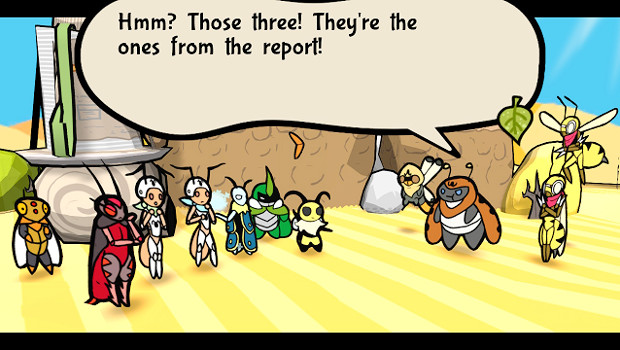 Plenty of twists and turns to the plot in Bug Fables, keeping things interesting.
Plenty of twists and turns to the plot in Bug Fables, keeping things interesting.
If you want to discover everything about the enemies in the game though, you will need to make regular use of the "Spy" skill, this can be used by any member of the party. It requires you to line up crosshairs over the enemy three times, which will reward you with information on the enemy (complete with unique dialogue depending on which party member uses the ability) resulting in an entry within the bestiary.
Further to this, once you reach a certain amount of these entries and get to a certain point in the game, you will be able to play "Spy Cards" which is a complete card game - a proper game in its own right - within Bug Fables. There's even a tournament where you can take part in. Even if you just want to collect the cards, then you'll need to complete all ninety entries, which will surely take a fair amount of time, offering yet more long-term value to this title, already of an impressive length.
With all this character- and world-building one can only hope we will see a sequel down the road, as we have grown quite fond of Bugaria and its dwellers.
As you can probably tell by now, this game does a lot of things right. However, there are some small gripes that hinder the fun every now and then. In order to level any real criticism at Bug Fables, it would really come down to looking at the small amount of things it gets wrong when compared to the game series it borrows heavily from. One of the worst parts for me is how some of the attacks from the bosses require you to button bash an excessive amount just to not take damage, because when it comes down to having to press the action button so much in such a short space of time, which ends up causing you - the player - damage, to avoid damage in the game... then you really start to weigh up if some battles are worth your time. But this is the trade off with such a battle system, which for the most part works well, just in these instances when fighting certain bosses, will really make you question whether it's worth the physical pain, for digital gain.
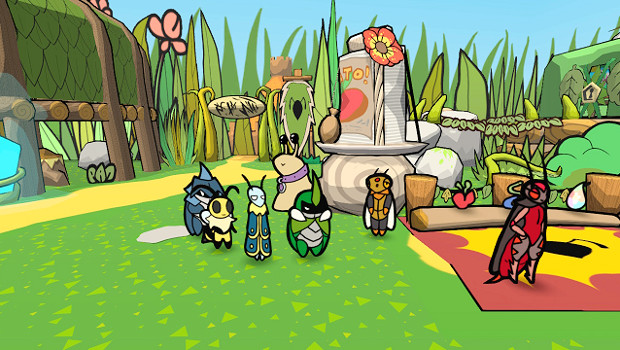 And the overworld isn't bad-looking either, check out the vibrant artstyle.
And the overworld isn't bad-looking either, check out the vibrant artstyle.
Another big one are the controls on the overworld. Although the paper aesthetic is great to look at, it makes navigation a bit sloppy. You often have to make jumps, hit objects with the boomerang, or move ice cubes (Leif the moth can use ice magic) in the right position. Because of the 2D-in-3D style, it is easy to not point in the right direction or to misjudge a jump.
Item management is another thing. Your inventory space is severely limited, but you can only store items at a post-ant in the towns. This is also an RPG where you really have to use and even rely on recovery items. TP drains fast and there are not many recovery or healing moves, so items are the solution. Where you usually finish a game with 99 potions and 40 antidotes, you will need them here.
You will also be wandering around a lot as fast-travel is unlocked fairly late in the game. Luckily, you quickly gain a medal that automatically kills weak enemies, so you can easily waltz through areas with weaker foes without the need for combat. And finally, although the story is great, and there is plenty of realization that you are a little bug (soda cans are used for houses and the like), we feel they could have integrated the whole bug theme more.
Okay, one more negative and then back to the positive. Games need to stop with obligatory stealth sequences, as they never really work. And this game is no exception to that.
One thing we will take away from playing Big Fables though, is the humour used in the game's script, as it is often sharp, funny, endearing, and spectacularly entertaining on many levels. This is perhaps the biggest strength of the entire game, especially in the way that the characters play off one another. Especially when it comes to Vi the sassy bee, as it is just simply a joy to beehold when you see her get into a flap one moment over something trivial (complete with an endearing "arm-flapping" animation), then the next being completely dismissive over major plot points in the game, as if beating a huge boss was no big deal. This is proof enough that any future Paper Mario game would do well to learn from the character traits in this charming title, as these characters really are going to be hard to match.
N-Europe Final Verdict
Bug Fables is a lovely RPG which is definitely inspired by the Paper Mario series, but has plenty on offer to stand on its own legs. It has an original setting, a colourful cast, witty dialogue, and great storytelling. Combat is fun and there is plenty to do, be it a card game, side quests, or just exploring every nook and cranny of the world for hidden stuff. There are a few niggles - such as the overworld controls - that stop it from being the perfect game, but we hope they will fix that in (fingers crossed!) a sequel.
- Gameplay4
- Playability4
- Visuals5
- Audio5
- Lifespan4
Final Score
9
Pros
Beautifully presented
Characters have plenty of depth
Humour is spot-on
Intuitive combat system
Sidequests which you'll want to complete
Cons
Navigation can prove tricky in places
Overzealous button-mashing is tiring


